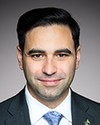Thank you very much.
It's an honour for me to be able to speak to you on such an important topic.
In late 2022, we see a relationship between Canada and China that remains very cool and is characterized by minimal engagement despite the importance of the issues in play.
While the release of Huawei's CFO Meng Wanzhou and Canadians Michael Kovrig and Michael Spavor over a year ago has removed the factors that weighed most heavily on the relationship, I see no significant rebound or any sign of a return to the previous complex web of exchanges at the leadership level, at the ministerial level or by federal and provincial officials.
Stringent COVID restrictions on the Chinese side have also prevented a resurgence of business visitors in both directions. The flow of Chinese students to Canada has partially resumed, but the nearly million-strong prepandemic wave of Chinese tourists to Canada awaits, at a minimum, the lifting of COVID regulations in China.
Beyond these mechanics, if I might say, of diplomatic, commercial and people-to-people connections, the erosion of trust on both sides, in my view, makes any early return to a pre-2019 bilateral relationship unlikely in the foreseeable future. An additional restraining factor is the predominantly negative view of China held by the Canadian public and media. On the Chinese side, the state-controlled media has lightened its criticism of Canadian policies towards China since the release of Meng Wanzhou, but there's a wariness that remains, in my view, on the part of Chinese officials towards Canada. One could say the relationship is in stasis or even stagnation.
Complicating any return to a more normal and more positive state-to-state relationship is the emergence of a number of Chinese domestic and international factors. I'll cite them very quickly. I've listed eight, I think.
The U.S.–China relationship is strained and getting more difficult, where both U.S. and PRC leaders engage in regular direct criticisms. There are the U.S. and PRC legislative and regulatory moves to restrict trade and investment.
The emergence of Taiwan is arguably the highest profile issue dividing Washington and Beijing. It is the factor that, in my view, has the greatest potential to generate open warfare between the two adversaries, with consequences, of course, for Canada.
Beijing's crackdown on Hong Kong—a territory with deep Canadian historical links and a massive constant presence of Canadian citizens—using the national security law hangs like a sword over our relationship with Hong Kong and with China.
Xinjiang, like Tibet, has been a matter of human rights concern for decades. I first visited in 1983 and I've seen a steady deterioration, not at the same pace, over time. Ongoing hardline Chinese policies show no sign of softening. I would note that while western concerns regarding Xinjiang are widely shared, most less-developed countries and Muslim-majority states remain silent on Xinjiang, which I think is unfortunate.
Allegations of interference in Canadian political affairs erode both public and government support for enhanced relations with Beijing.
Limited Chinese support for Moscow's war in Ukraine is unhelpful, although there are signs of an increasing Chinese wariness regarding Russian war aims.
The pending announcement of a Canadian Indo-Pacific strategy will be seen, or at least portrayed, by Beijing as part of a U.S.-led strategy to isolate and contain China.
The positive side is limited. Bilateral trade is relatively stable, although with the exceptions of western agricultural products and Atlantic seafood, our exports have a very low profile with Canadians. Chinese imports continue to be roughly triple the size of our exports. The movement to reduce dependence on Chinese supply chains is very modest.
Whatever one thinks of Chinese domestic and international policies, I see danger in the absence of substantive dialogue between Ottawa and Beijing. U.S. Defense Secretary Austin last week lamented the suspension by China of regular military consultations between the U.S. Department of Defense and the PLA, recognizing this gap carries risks, especially in a crisis. Similarly, the absence of sustained communication between our capitals, Ottawa and Beijing, carries risks and even lost opportunities for Canada.
In late September, the China Institute at the University of Alberta and the People's Republic of Chinse People's Institute of Foreign Affairs—it's a quasi-government body—held one of the few, if not the only remaining, consultations with Chinese officials and former officials. That dialogue has some value, but it doesn't begin to be a substitute for a robust range of official exchanges.
Finally, other than limited prospects, I don't see a swift return to a normal bilateral relationship given the issues I've cited. Barring a new and sharply negative event, which is always possible, the mostly likely course might be a slow return to a more regular pattern of exchanges and visits, such as our European allies have in general. It would be limited, again, by the issues I've provided above. Dialogue and communication of divergent positions need not mean either weakness or appeasement.
Thank you.










